2022年英语中考语法复习(第五部分-介词)课件(共26张PPT)
文档属性
| 名称 | 2022年英语中考语法复习(第五部分-介词)课件(共26张PPT) |  | |
| 格式 | pptx | ||
| 文件大小 | 1.8MB | ||
| 资源类型 | 教案 | ||
| 版本资源 | 通用版 | ||
| 科目 | 英语 | ||
| 更新时间 | 2022-05-03 20:45:42 | ||
图片预览

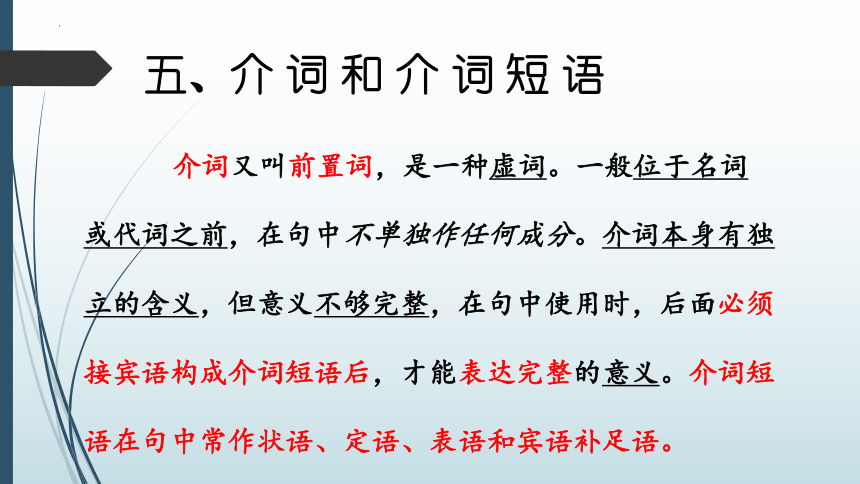
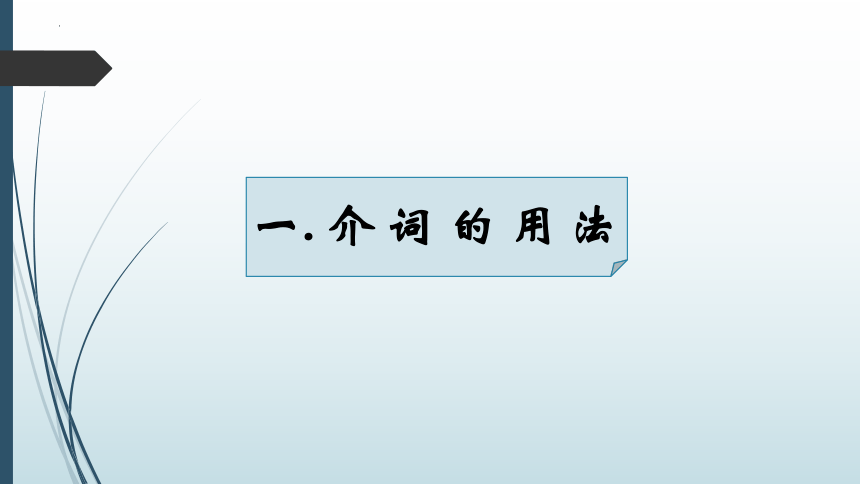
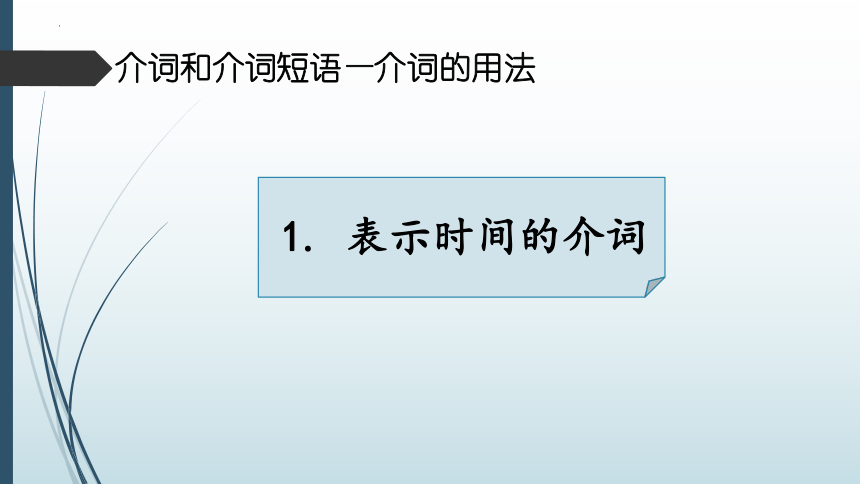

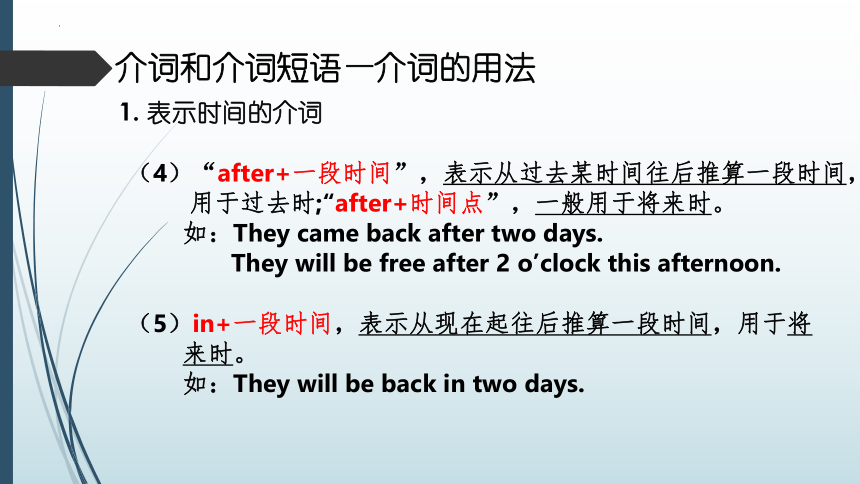
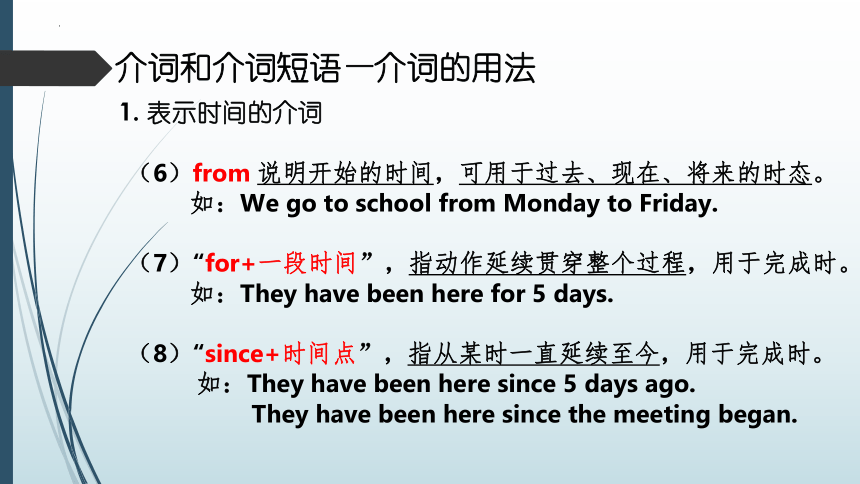
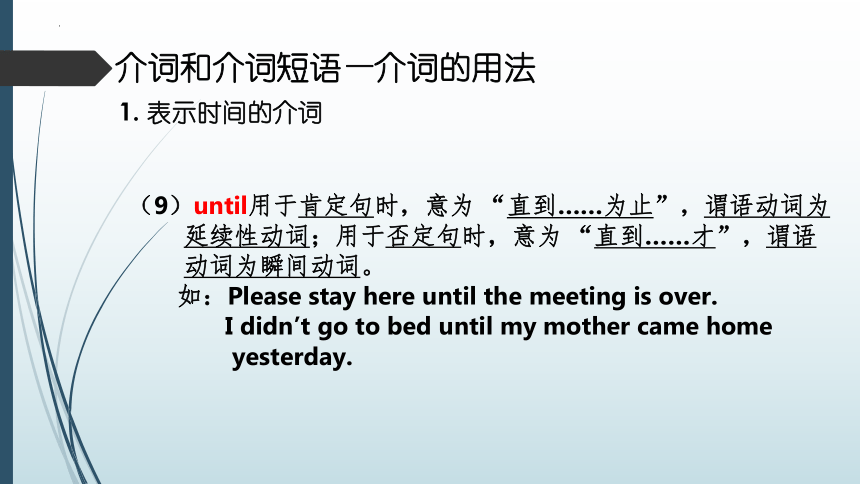
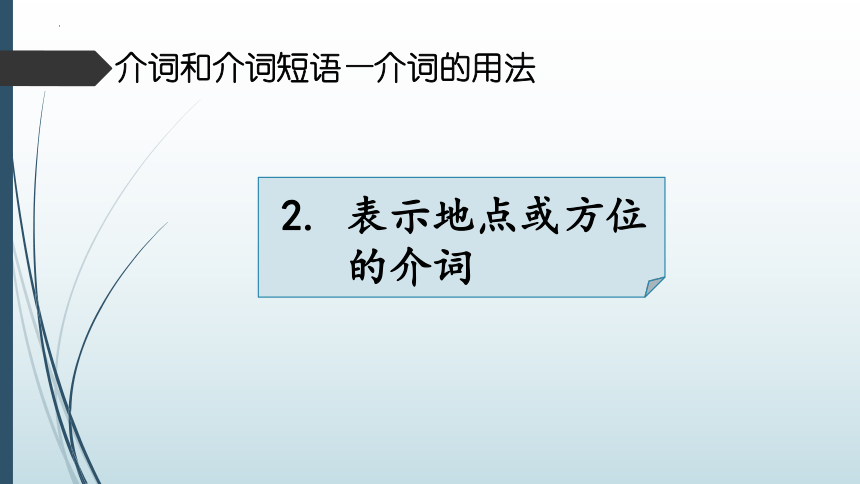
文档简介
(共26张PPT)
英语中考语法复习
五、介 词 和 介 词 短 语
介词又叫前置词,是一种虚词。一般位于名词或代词之前,在句中不单独作任何成分。介词本身有独立的含义,但意义不够完整,在句中使用时,后面必须接宾语构成介词短语后,才能表达完整的意义。介词短语在句中常作状语、定语、表语和宾语补足语。
一. 介 词 的 用 法
1. 表示时间的介词
介词和介词短语—介词的用法
1. 表示时间的介词
(1)at 表示某一时刻、某一钟点或假期期间。
如:I woke up at 7 o’clock.
(2)on表示具体某一天或具体某一天的上午、下午和晚上。
如:The story happened on a cold winter night.
(3)in 表示月份、季节、年份、世纪、上下午、晚上。
如: My birthday is in February.
Life was different in 19th century.
介词和介词短语—介词的用法
1. 表示时间的介词
(4)“after+一段时间”,表示从过去某时间往后推算一段时间,
用于过去时;“after+时间点”,一般用于将来时。
如:They came back after two days.
They will be free after 2 o’clock this afternoon.
(5)in+一段时间,表示从现在起往后推算一段时间,用于将
来时。
如:They will be back in two days.
介词和介词短语—介词的用法
1. 表示时间的介词
(6)from 说明开始的时间,可用于过去、现在、将来的时态。
如:We go to school from Monday to Friday.
(7)“for+一段时间”,指动作延续贯穿整个过程,用于完成时。
如:They have been here for 5 days.
(8)“since+时间点”,指从某时一直延续至今,用于完成时。
如:They have been here since 5 days ago.
They have been here since the meeting began.
介词和介词短语—介词的用法
1. 表示时间的介词
(9)until用于肯定句时,意为 “直到……为止”,谓语动词为
延续性动词;用于否定句时,意为 “直到……才”,谓语
动词为瞬间动词。
如:Please stay here until the meeting is over.
I didn’t go to bed until my mother came home
yesterday.
介词和介词短语—介词的用法
2. 表示地点或方位
的介词
介词和介词短语—介词的用法
2. 表示地点或方位的介词
介词和介词短语—介词的用法
2. 表示地点或方位的介词
介词和介词短语—介词的用法
(1)at 表示 “某一点的位置或具体位置 (较小的地方)”。
如:He arrived at the village late last night.
(2)in 表示 “在某一个范围内 (大地方)”。
如:He arrived in Beijing 2 hours ago.
(3)in 表示 “在某一个范围内”。
如:Zhuhai is in Guangdong.
2. 表示地点或方位的介词
介词和介词短语—介词的用法
(4)on表示 “两地接壤”
如: Guangdong is on the south of Hunan.
(5)to表示 “两地相隔”
如:Hainan is to the south of Guangdong.
(6)between表示 “在两者之间”
如:I sit between Jane and Mary.
2. 表示地点或方位的介词
介词和介词短语—介词的用法
(7)among表示 “在 (三者或以上) 的之中”。
如: The song is very popular among teenagers.
(8)across表示 “表面横过”。
如: Be careful while walking across the street.
(9)past表示 “侧面经过”。
如:Don’t forget to call me when walking past my
house.
2. 表示地点或方位的介词
介词和介词短语—介词的用法
(10)through表示 “内部穿过”。
如:The light goes into the room through the window.
(11)on表示 “在……的表面上”,两者有接触。
如: There is a book on the desk.
(12)over表示 “在……的正上方”,多暗示悬空,反义词为
under。
如: There is a bridge over the river.
2. 表示地点或方位的介词
介词和介词短语—介词的用法
(13)above表示 “在……的上方”,但不一定在正上方,也不接
触另一物,反义词为below。
如:There is a bird flying above the bridge.
(14)below表示 “在……的下方”。
如:The radio said the temperature would be below
zero.
(15)under表示 “在……的正下方”。
如:There is a book under the desk。
2. 表示地点或方位的介词
介词和介词短语—介词的用法
(16)at泛指在某个位置。
如:She’s at the table.
(17)beside常用语,表示 “在……旁边” 。
如: She sits beside John.
(18)by强调 “紧贴” 。
如:She sits by John.
2. 表示地点或方位的介词
介词和介词短语—介词的用法
(19)near表示 “在……附近”,比by表示的距离远得多。
如:She stands near John.
(20)next to表示 “紧靠……的旁边” 。
如:She stands next to John.
3.表示手段、工具
或方式的介词
介词和介词短语—介词的用法
3.表示手段、工具或方式的介词
介词和介词短语—介词的用法
(1)by表示用某种方法、手段或交通工具。
如: by bike,by Internet,by selling flowers
(2)in表示用某种方式,后可接表示语言、声音、颜色、材料
等名词。
如: in English,in red
(3)with表示用某种具体的工具或手段。
如: write with a pen
介词和介词短语—介词的用法
(4)on表示用某种方式,后可接表示交通工具、手段、通讯
方式等名词。
如: on the telephone,on the radio,on TV
3.表示手段、工具或方式的介词
4.其他常用介词
介词和介词短语—介词的用法
4.其他常用介词
介词和介词短语—介词的用法
(1)except指从整体中排除,意为 “除了…… (不包括在内)”,
常与表示完全肯定或完全否定的词连用。
如:All of us went to the zoo last Sunday except John.
(2)besides指 “除了……之外 (还有)”,常与also,other,
another等连用。
如: All of us went to the zoo last Sunday besides John.
介词和介词短语—介词的用法
(3)but表示 “除了……什么也没有”,多与nobody,
nothing连用。
如: There is nothing but a bed in the room.
(4)against表示 “反对,违背”,反义词为for,常用短语
为play against意为 “与……对抗”,be strongly against
意为 “强调反对”。
如:We played against Class 9 yesterday afternoon.
4.其他常用介词
介词和介词短语—介词的用法
(5)beyond表示 “超出,多于,为……所不能及”,用来修饰
范围、水平、限度和能力等。
如: The problem is far beyond me. I’m afraid I can’t
work it out.
(6)as表示 “作为,以……身份”,后面接表示职业、职务、
身份的名词。
如: He is famous as a writer.
4.其他常用介词
介词和介词短语—介词的用法
(7)like表示 “像……一样”,用于说明相似关系,实际上不是。
如: The girl looks like her father.
(8)with表示 “和,同,与……,带着,随着”。
如:I often go shopping with my mother.
(9)without表示 “没有”。
如:I can’t finish the task without your help.
4.其他常用介词
Goodbye!
英语中考语法复习
五、介 词 和 介 词 短 语
介词又叫前置词,是一种虚词。一般位于名词或代词之前,在句中不单独作任何成分。介词本身有独立的含义,但意义不够完整,在句中使用时,后面必须接宾语构成介词短语后,才能表达完整的意义。介词短语在句中常作状语、定语、表语和宾语补足语。
一. 介 词 的 用 法
1. 表示时间的介词
介词和介词短语—介词的用法
1. 表示时间的介词
(1)at 表示某一时刻、某一钟点或假期期间。
如:I woke up at 7 o’clock.
(2)on表示具体某一天或具体某一天的上午、下午和晚上。
如:The story happened on a cold winter night.
(3)in 表示月份、季节、年份、世纪、上下午、晚上。
如: My birthday is in February.
Life was different in 19th century.
介词和介词短语—介词的用法
1. 表示时间的介词
(4)“after+一段时间”,表示从过去某时间往后推算一段时间,
用于过去时;“after+时间点”,一般用于将来时。
如:They came back after two days.
They will be free after 2 o’clock this afternoon.
(5)in+一段时间,表示从现在起往后推算一段时间,用于将
来时。
如:They will be back in two days.
介词和介词短语—介词的用法
1. 表示时间的介词
(6)from 说明开始的时间,可用于过去、现在、将来的时态。
如:We go to school from Monday to Friday.
(7)“for+一段时间”,指动作延续贯穿整个过程,用于完成时。
如:They have been here for 5 days.
(8)“since+时间点”,指从某时一直延续至今,用于完成时。
如:They have been here since 5 days ago.
They have been here since the meeting began.
介词和介词短语—介词的用法
1. 表示时间的介词
(9)until用于肯定句时,意为 “直到……为止”,谓语动词为
延续性动词;用于否定句时,意为 “直到……才”,谓语
动词为瞬间动词。
如:Please stay here until the meeting is over.
I didn’t go to bed until my mother came home
yesterday.
介词和介词短语—介词的用法
2. 表示地点或方位
的介词
介词和介词短语—介词的用法
2. 表示地点或方位的介词
介词和介词短语—介词的用法
2. 表示地点或方位的介词
介词和介词短语—介词的用法
(1)at 表示 “某一点的位置或具体位置 (较小的地方)”。
如:He arrived at the village late last night.
(2)in 表示 “在某一个范围内 (大地方)”。
如:He arrived in Beijing 2 hours ago.
(3)in 表示 “在某一个范围内”。
如:Zhuhai is in Guangdong.
2. 表示地点或方位的介词
介词和介词短语—介词的用法
(4)on表示 “两地接壤”
如: Guangdong is on the south of Hunan.
(5)to表示 “两地相隔”
如:Hainan is to the south of Guangdong.
(6)between表示 “在两者之间”
如:I sit between Jane and Mary.
2. 表示地点或方位的介词
介词和介词短语—介词的用法
(7)among表示 “在 (三者或以上) 的之中”。
如: The song is very popular among teenagers.
(8)across表示 “表面横过”。
如: Be careful while walking across the street.
(9)past表示 “侧面经过”。
如:Don’t forget to call me when walking past my
house.
2. 表示地点或方位的介词
介词和介词短语—介词的用法
(10)through表示 “内部穿过”。
如:The light goes into the room through the window.
(11)on表示 “在……的表面上”,两者有接触。
如: There is a book on the desk.
(12)over表示 “在……的正上方”,多暗示悬空,反义词为
under。
如: There is a bridge over the river.
2. 表示地点或方位的介词
介词和介词短语—介词的用法
(13)above表示 “在……的上方”,但不一定在正上方,也不接
触另一物,反义词为below。
如:There is a bird flying above the bridge.
(14)below表示 “在……的下方”。
如:The radio said the temperature would be below
zero.
(15)under表示 “在……的正下方”。
如:There is a book under the desk。
2. 表示地点或方位的介词
介词和介词短语—介词的用法
(16)at泛指在某个位置。
如:She’s at the table.
(17)beside常用语,表示 “在……旁边” 。
如: She sits beside John.
(18)by强调 “紧贴” 。
如:She sits by John.
2. 表示地点或方位的介词
介词和介词短语—介词的用法
(19)near表示 “在……附近”,比by表示的距离远得多。
如:She stands near John.
(20)next to表示 “紧靠……的旁边” 。
如:She stands next to John.
3.表示手段、工具
或方式的介词
介词和介词短语—介词的用法
3.表示手段、工具或方式的介词
介词和介词短语—介词的用法
(1)by表示用某种方法、手段或交通工具。
如: by bike,by Internet,by selling flowers
(2)in表示用某种方式,后可接表示语言、声音、颜色、材料
等名词。
如: in English,in red
(3)with表示用某种具体的工具或手段。
如: write with a pen
介词和介词短语—介词的用法
(4)on表示用某种方式,后可接表示交通工具、手段、通讯
方式等名词。
如: on the telephone,on the radio,on TV
3.表示手段、工具或方式的介词
4.其他常用介词
介词和介词短语—介词的用法
4.其他常用介词
介词和介词短语—介词的用法
(1)except指从整体中排除,意为 “除了…… (不包括在内)”,
常与表示完全肯定或完全否定的词连用。
如:All of us went to the zoo last Sunday except John.
(2)besides指 “除了……之外 (还有)”,常与also,other,
another等连用。
如: All of us went to the zoo last Sunday besides John.
介词和介词短语—介词的用法
(3)but表示 “除了……什么也没有”,多与nobody,
nothing连用。
如: There is nothing but a bed in the room.
(4)against表示 “反对,违背”,反义词为for,常用短语
为play against意为 “与……对抗”,be strongly against
意为 “强调反对”。
如:We played against Class 9 yesterday afternoon.
4.其他常用介词
介词和介词短语—介词的用法
(5)beyond表示 “超出,多于,为……所不能及”,用来修饰
范围、水平、限度和能力等。
如: The problem is far beyond me. I’m afraid I can’t
work it out.
(6)as表示 “作为,以……身份”,后面接表示职业、职务、
身份的名词。
如: He is famous as a writer.
4.其他常用介词
介词和介词短语—介词的用法
(7)like表示 “像……一样”,用于说明相似关系,实际上不是。
如: The girl looks like her father.
(8)with表示 “和,同,与……,带着,随着”。
如:I often go shopping with my mother.
(9)without表示 “没有”。
如:I can’t finish the task without your help.
4.其他常用介词
Goodbye!
同课章节目录
- 词法
- 名词
- 动词和动词短语
- 动词语态
- 动词时态
- 助动词和情态动词
- 非谓语动词
- 冠词
- 代词
- 数词和量词
- 形容词副词及其比较等级
- 介词和介词短语
- 连词和感叹词
- 构词法
- 相似、相近词比较
- 句法
- 陈述句
- 一般疑问句和否定疑问句
- 特殊疑问句及选择疑问句
- 反意疑问句
- 存在句(There be句型)
- 宾语从句
- 定语从句
- 状语从句
- 主谓一致问题
- 简单句
- 并列句
- 复合句
- 主谓一致
- 主、表语从句
- 名词性从句
- 直接引语和间接引语
- 虚拟语气
- 感叹句
- 强调句
- 倒装句
- 祈使句
- 句子的成分
- 句子的分类
- 题型专区
- 单项选择部分
- 易错题
- 完形填空
- 阅读理解
- 词汇练习
- 听说训练
- 句型转换
- 补全对话
- 短文改错
- 翻译
- 书面表达
- 任务型阅读
- 语法填空
- 其他资料
